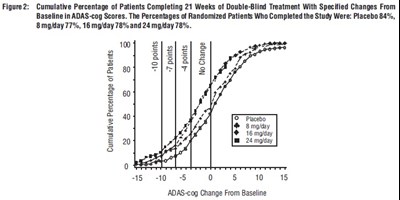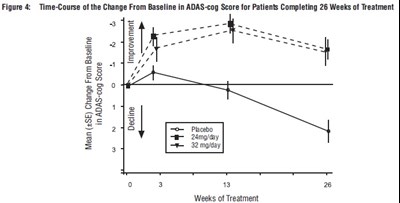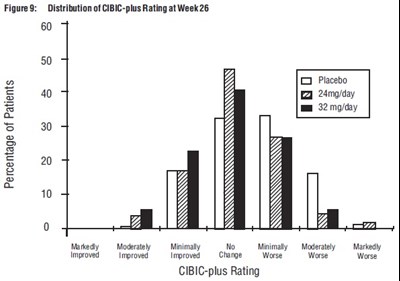Product Images Galantamine
View Photos of Packaging, Labels & Appearance
- Figure 1: Time-Course of the Change From Baseline in ADAS-cog Score for Patients Completing 21 Weeks (5 Months) of Treatment - galantamine fig1
- Figure 10: Time-Course of the Change From Baseline in ADAS-cog Score for Patients Completing 13 Weeks of Treatment - galantamine fig10
- Figure 11: Cumulative Percentage of Patients Completing 13 Weeks of Double-Blind Treatment With Specified Changes from Baseline in ADAS-cog Scores. The Percentages of Randomized Patients Who Completed the Study Were: Placebo 90%, 24 to 32 mg/day 67%. - galantamine fig11
- Figure 12: Distribution of CIBIC-plus Ratings at Week 13 - galantamine fig12
- PACKAGE LABEL-PRINCIPAL DISPLAY PANEL - 8 mg (30 Capsules Bottle) - galantamine fig13
- PACKAGE LABEL-PRINCIPAL DISPLAY PANEL - 16 mg (30 Capsules Bottle) - galantamine fig14
- PACKAGE LABEL-PRINCIPAL DISPLAY PANEL - 24 mg (30 Capsules Bottle) - galantamine fig15
- Figure 2: Cumulative Percentage of Patients Completing 21 Weeks of Double-Blind Treatment With Specified Changes From Baseline in ADAS-cog Scores. The Percentages of Randomized Patients Who Completed the Study Were: Placebo 84%, 8 mg/day 77%, 16 mg/day 78% and 24 mg/day 78%. - galantamine fig2
- Figure 3: Distribution of CIBIC-plus Ratings at Week 21 - galantamine fig3
- Figure 4: Time-Course of the Change From Baseline in ADAS-cog Score for Patients Completing 26 Weeks of Treatment - galantamine fig4
- Figure 5: Cumulative Percentage of Patients Completing 26 Weeks of Double-Blind Treatment With Specified Changes From Baseline in ADAS-cog Scores. The Percentages of Randomized Patients Who Completed the Study Were: Placebo 81%, 24 mg/day 68%, and 32 mg/day 58%. - galantamine fig5
- Figure 6: Distribution of CIBIC-plus Ratings at Week 26 - galantamine fig6
- Figure 7: Time-Course of the Change From Baseline in ADAS-cog Score for Patients Completing 26 Weeks of Treatment - galantamine fig7
- Figure 8: Cumulative Percentage of Patients Completing 26 Weeks of Double-Blind Treatment With Specified Changes From Baseline in ADAS-cog Scores. The Percentages of Randomized Patients Who Completed the Study Were: Placebo 87%, 24 mg/day 80%, and 32 mg/day 75%. - galantamine fig8
- Figure 9: Distribution of CIBIC-plus Rating at Week 26 - galantamine fig9
- galantamine-str - galantamine str
Product Label Images
The following 16 images provide visual information about the product associated with Galantamine NDC 65862-744 by Aurobindo Pharma Limited, such as packaging, labeling, and the appearance of the drug itself. This resource could be helpful for medical professionals, pharmacists, and patients seeking to verify medication information and ensure they have the correct product.
Figure 1: Time-Course of the Change From Baseline in ADAS-cog Score for Patients Completing 21 Weeks (5 Months) of Treatment - galantamine fig1

This is a figure showing the time-course of change from baseline in ADAS-cog score for patients completing 21 weeks (5 months) of treatment. There is no additional information available.*
Figure 10: Time-Course of the Change From Baseline in ADAS-cog Score for Patients Completing 13 Weeks of Treatment - galantamine fig10

The text is a partial title and caption of a graph showing the progression of ADAS-cog score changes for patients undergoing treatment for 13 weeks. The graph shows a time-course with a mean change from baseline in the score. Specific data points and measurements are included.*
Figure 11: Cumulative Percentage of Patients Completing 13 Weeks of Double-Blind Treatment With Specified Changes from Baseline in ADAS-cog Scores. The Percentages of Randomized Patients Who Completed the Study Were: Placebo 90%, 24 to 32 mg/day 67%. - galantamine fig11

The text describes a figure showing the percentage of patients completing a double-blind treatment for 13 weeks and the changes from the baseline in ADAS-cog scores. The figures show that 90% of patients who received a placebo completed the study while only 67% of patients who received 241032 my/day completed the study. The X-axis displays ADAS-cog change from baseline while the Y-axis shows the cumulative percentage of patients. The figure shows 10 points, no change, and a gradual decrease in the percentage of patients as ADAS-cog change from Baseline increases.*
Figure 12: Distribution of CIBIC-plus Ratings at Week 13 - galantamine fig12

The text describes a figure (Figure 12) showing the distribution of CIBIC-plus ratings at week 13. The figure includes percentages of patients falling into different rating categories (Markedly Improved, Moderately Improved, Minimally Improved, No Change, and Worse) for two dosage levels (24 or 32 mg/day) and a placebo group.*
PACKAGE LABEL-PRINCIPAL DISPLAY PANEL - 8 mg (30 Capsules Bottle) - galantamine fig13

Galantamine is a prescription drug available in extended-release capsules form with a strength of 8mg galantamine as 10.25 mg galantamine hydrobromide. It is distributed by Aurabindo Pharma USA, Inc. and made in India. The code for this drug is TS/DRUGS/22/2009. The usual dosage can be seen in the accompanying package insert. It is recommended to store it at a temperature of 20-25°C (66° to 77°F) and keep out of the reach of children. Additionally, a GTIN, serial number, expiry date, and LOT are printed during packing.*
PACKAGE LABEL-PRINCIPAL DISPLAY PANEL - 16 mg (30 Capsules Bottle) - galantamine fig14

The text appears to be a description of a medication called Galantamine, which is in extended-release capsule form. The medication is distributed by Aurobindo Pharma USA and contains 16 mg of galantamine hydrobromide per capsule. The capsules should be stored at a temperature between 20-25°C and kept out of reach of children. The packaging includes information such as the GTIN, serial number, expiry date, and Lot number. The text also includes a warning label stating that the medication should only be taken with prescription (Rx Only).*
PACKAGE LABEL-PRINCIPAL DISPLAY PANEL - 24 mg (30 Capsules Bottle) - galantamine fig15

This is a description for a medication called Galantamine, which comes in the form of extended-release capsules made in India and distributed in the United States by Aurobindo Pharma USA. Each capsule contains 24 mo galantamine hydrobromide, USP, with a usual dosage of S accomganin pckage. The capsules should be stored at 20-25°C (68-77°F) and kept out of reach of children. There is additional information regarding packaging and printing of information on the capsules, but no details on the specific use or effects of the medication.*
Figure 2: Cumulative Percentage of Patients Completing 21 Weeks of Double-Blind Treatment With Specified Changes From Baseline in ADAS-cog Scores. The Percentages of Randomized Patients Who Completed the Study Were: Placebo 84%, 8 mg/day 77%, 16 mg/day 78% and 24 mg/day 78%. - galantamine fig2

The text describes a figure (Figure2) representing the percentage of patients who completed a 21-week double-blind treatment and their corresponding changes from baseline in ADAS-cog scores. The study was conducted on patients receiving different doses of a drug called "ltay". The percentages of patients who completed the study were provided for each dose group: placebo (84%), 8mg/day (77%), 16 mg/day (78%), and 24 mg/day (78%). The figure also shows a graph with ADAS-cog change scores on the x-axis and cumulative percentage of patients on the y-axis for each dose group.*
Figure 3: Distribution of CIBIC-plus Ratings at Week 21 - galantamine fig3

The figure shows the distribution of CIBIC-plus ratings at Week 21, represented by different dosages and placebo. The rating categories include markedly improved, moderately improved, minimally improved, no change, moderately worse, and markedly worse. The percentage of patients in each rating category is displayed.*
Figure 4: Time-Course of the Change From Baseline in ADAS-cog Score for Patients Completing 26 Weeks of Treatment - galantamine fig4

The text provides a figure labeled "Figure 4" that shows the time-course of the change in ADAS-cog score for patients who completed 26 weeks of treatment. The mean (+SE) change from baseline in ADAS-cog score is presented on the y-axis, while the x-axis displays the weeks of treatment. The graph includes three lines, representing the improvement in ADAS-cog score for the 24mg/day treatment group, the placebo group, and the B2 maya group.*
Figure 5: Cumulative Percentage of Patients Completing 26 Weeks of Double-Blind Treatment With Specified Changes From Baseline in ADAS-cog Scores. The Percentages of Randomized Patients Who Completed the Study Were: Placebo 81%, 24 mg/day 68%, and 32 mg/day 58%. - galantamine fig5

This is a figure showing cumulative percentage of patients completing a 26-week double-blind treatment. The percentage of randomized patients completing the study with changes from baseline in ADAS-cog scale were: Placebo 1%, 24mg/day 68%, and 32mg/day 58%. The figure also shows ADAS-cog change from baseline with points ranging from -10 to No Change to +4.*
Figure 7: Time-Course of the Change From Baseline in ADAS-cog Score for Patients Completing 26 Weeks of Treatment - galantamine fig7

The figure 7 shows the time-course of the change in ADAS-cog score for patients who completed 26 weeks of treatment. The graph displays the mean (+SE) change from baseline in ADAS-cog score with improvement. The text also shows the dosage of placebo, 24mg/day, and 32mg/day. Overall, this information seems to be a part of a scientific or medical research report.*
Figure 8: Cumulative Percentage of Patients Completing 26 Weeks of Double-Blind Treatment With Specified Changes From Baseline in ADAS-cog Scores. The Percentages of Randomized Patients Who Completed the Study Were: Placebo 87%, 24 mg/day 80%, and 32 mg/day 75%. - galantamine fig8

The figure shows the percentage of patients who completed 26 weeks of double-blind treatment with specified changes from Baseline in ADAS-cog scores. The study included randomized patients who were given Placebo, 24my/day and 32 my/day. The percentage of patients who completed the study were Placebo 87%, 24my/day 80%, and 32 my/day 75%.*
Figure 9: Distribution of CIBIC-plus Rating at Week 26 - galantamine fig9

The text describes a figure labeled as "Figure 9". It shows a graph displaying the distribution of CIBIC-plus rating of patients at week 26. There are six sections marked as A, O, Placebo, and different doses of medication (24mg/day and 32mg/day). The rating scale ranges from "Not improved" to "Markedly improved". The graph also includes percentages of patients at each level of rating.*
* The product label images have been analyzed using a combination of traditional computing and machine learning techniques. It should be noted that the descriptions provided may not be entirely accurate as they are experimental in nature. Use the information in this page at your own discretion and risk.

